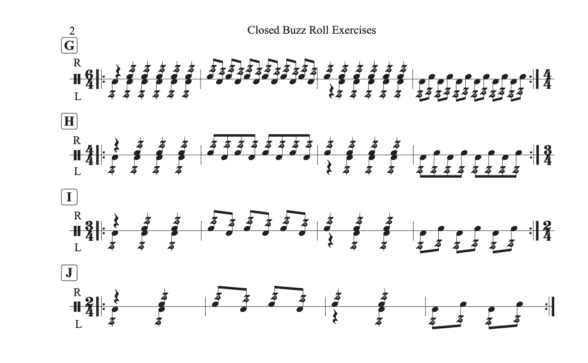Developing a closed buzz roll on snare drum is essential. Not only for a concert percussionist, but also for a drum set player. The primary reason to “roll” on a snare drum is to sustain sound. Stringed instruments can continually draw a bow across a string to sustain a note. Wind instruments can continually blow air through the horn to sustain a note. But drums have a very quick decay time. Especially the snare drum. Once you strike the drum, the sound almost immediately decays to silence. So to give the “impression” that the drum is sustaining a note, we strike the drum head as often as we can – which is called a roll.
“Drum Roll Please”
There are three types of rolls: 1) Single Stroke 2) Open Roll 3) Closed Roll. The single stroke roll is rapidly striking the drum with alternating strokes (RLRLRLRL). A single stroke roll is usually used on drums with loose head tensions such as toms and concert bass drum and percussion instruments with a long sustain such as cymbals, triangles, timpani and keyboard mallet instruments.
Open Roll
The Open Roll allows the sticks to EVENLY bounce ONLY two times for each stroke. This is commonly referred to with the two syllable word: “Diddle”. 8th note strokes (R L R L) become even 16th note diddles (RR LL RR LL). Similarly, 16th note strokes become 32nd note diddles. Which is historically why rolls are notated with three slashes since 32nd notes have 3 flags or beams. Open Diddle rolls are generally used in marching band or rudimental style drumming.
Closed Roll
The Closed Roll allows the sticks to bounce multiple times for each stroke. This is commonly referred to as: “Buzz”. There will be an indeterminate number of times the stick will bounce for each stroke depending on the rate of the strokes. The slower the stroke rate (tempo) the more rebounds. The goal and objective is to have the end of each buzz flow into the start of the next buzz. There should be a smooth consistent sustained sound. Closed Buzz rolls are without doubt the most common type of roll used on snare drum.
Smooth Consistent Sustained Sound
Remember: “There should be a smooth consistent sustained sound“. That can only be achieved by having an identical buzz sound between each hand (stroke). Focus on achieving the same rate (speed of multiple rebounds) and length. The following is one of the exercise I practice to develop a consistent buzz sound:

The top line (stems up) is the right hand (R) and the bottom line (stems down) is the left hand (L). You will plays hands together and hands separately. I notated the multiple rebound buzz with a Z rather than 3 slash 32nd notes. Start at a VERY SLOW tempo. Allow the sticks to buzz for as long as possible. Even allowing for a break in sound between strokes. Think whole or half notes. At slow tempos the strokes likely will not be connected. Carefully listen to the sound of each buzz. Focus on trying to get both hand to sound exactly the same – ie. having the same rate and length. Maintain the same stick height. Gradually increase speed (tempo).
Begin to Execute a Closed Buzz Roll – Alternating Strokes ( R L R L)

Again start slow. Listen to the sound of each buzz. Focus on getting each hand to sound exactly the same – having the same rate and length. You want there to be a seamless connection between the alternating strokes (hands). There should be no noticable difference between the left or right hands. Gradually increase your speed (tempo). Begin to think of the quarter notes as eighth notes and the eighth notes as sixteenth notes – Cut-Time or Alla Breve (2/2). And think of the 6/4 exercises as 6/8 or as Triplets and Sextuplets.
You will eventually find a “Sweet Spot” where the tempo allows for the most consistent connection between the buzz rate and the alternation of hands (strokes). I refer to the rate of alternating strokes as the Underlying Pulse.
Tempo Determines Underlying Pulse
Here is a simple example of a quarter note roll. Let’s say my “Sweet Spot” is 16th notes at around 120 BPM (Allegro). To maintain that “Sweet Spot” the underlying pulse (alternating hands) needs to be adjusted based on the tempo.

I’m sure at some point, one of my percussion teachers told be about underlying pulse. But I wasn’t paying attention. I just adjusted my roll speeds (trial and error) without fully understanding what I was doing. Now I will carefully look at the tempo and make an informed decision about what underlying pulse will produce a smooth consistent closed buzz roll.
Conclusions
I have included an expanded list of exercises to help develop a closed buzz roll. Feel free to make up your own variations. A consistent buzz roll is essential to becoming a good drum set player and percussionist. Not being able to produce a smooth sustained roll would be like a brass player not being able to hold a smooth sustained long tone. Also do NOT overlook practicing at different dynamic levels. So get your “Buzz On” and find your “Sweet Spot” by practicing these exercises and developing a closed buzz roll.


You may also want to see: Reed Syncopation Roll Accents, Drum Set Method Book Recommendations and for a really in depth discussion of developing a closed buzz roll see: William James, The Modern Concert Snare Drum Roll

